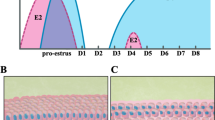Abstract
Progesterone (P4) is essential for the development of endometrial receptivity for blastocyst implantation and pregnancy maintenance. Many studies have demonstrated that P4 restrains endometrial tissue breakdown by inhibiting the stimulation of matrix metalloproteinases (MMPs), which implies that P4 impedes the invasion of trophoblast cells into endometrial tissue. To investigate the role of P4 on the attachment and invasion of the trophoblast cells in the entire process of embryo implantation, we used two in vitro coculture systems of blastocysts on a monolayer of uterine epithelial cells and ectoplacental cone (EPC) on uterine decidual cells. The results indicated that all doses of P4 significantly promoted blastocyst attachment, and that except for a concentration of 3.18×10−8 mol/L, P4 markedly increased the percentage of blastocysts with outgrowth. However, all concentrations of RU486 clearly prevented blastocyst attachment, and except for a concentration of 10−8 mol/L, all doses of RU486 significantly inhibited the outgrowth of blastocysts. The effect of 3.18×10−6 mol/L of P4 on the attachment and outgrowth of blastocysts was significantly blocked by all concentrations of RU486. All concentrations of P4 retarded the attachment of EPC on uterine decidual cells and decreased the outgrowth area of EPC. Except for a concentration of 3.18×10−8 mol/L, all concentrations of P4 had a significant inhibitory effect on the percentage of EPC outgrowth. Conversely, except for a concentration of 10−8 mol/L, all doses of RU486 had a significant stimulatory effect on the attachment of EPC. All concentrations of RU486 clearly promoted the outgrowth and outgrowth area of EPC. The inhibitory effect of P4 on EPC was clearly blocked by all doses of RU486. In addition, P4 promoted the activity of MMP-2 on blastocysts and EPC, but P4 inhibited the activity of MMP-9 on EPC. In summary, P4 played dual roles at the early and late stages of embryo implantation in mouse. When blastocysts interacted with the uterine epithelial cells, P4 promoted the attachment and invasion of the primary trophoblast giant cells. When EPC was in contact with uterine decidual cells, P4 inhibited the attachment and invasion of the secondary trophoblast giant cells. Furthermore, the role of P4 was transduced through the classic nuclear receptor.
Similar content being viewed by others
References
Gardner, R. L. and Papaioannou, V. E. (1975). In: The early development of mammals. Cambridge University Press, pp. 107–132.
Romagnano, L. and Babiarz, B. (1990). Dev. Biol. 141(2), 254–261.
Dey, S. K. and Johnson, D. C. (1986). Ann. NY Acad. Sci. 476, 49–62.
Bartol, F. F., Roberts, R. M., Bazer, F. W., and Thatcher, W. W. (1985). Biol. Reprod. 33, 745–759.
Geisert, R. D., Fox, T. C., Morgan, G. L., Wells, M. E., Wettemann, R. P., and Zavy, M. T. (1991). J. Reprod. Fertil. 92, 475–482.
Ashworth, C. J. and Bazer, F. W. (1989). Biol. Reprod. 40(2), 425–433.
Stites, D. P. and Siiteri, P. K. (1983). Immunol. Rev. 75, 117–138.
Szekeres-Bartho, J., Faust, Z., and Varga, P. (1995). Am. J. Reprod. Immunol. 34(6), 342–348.
Rothchild, I. (1983). In: Progesterone and progestins. Raven: New York, pp. 219–229.
Osteen, K. G., Bruner-Tran, K. L., Ong, D., and Eisenberg, E. (2002). Ann. NY Acad. Sci. 955, 139–146.
Keller, N. R., Sierra-Rivera, E., Eisenberg, E., and Osteen, K. G. (2000). J. Clin. Endocrinol. Metab. 85(4), 1611–1619.
Lockwood, C. J., Krikun, G., Hausknecht, V. A., Papp, C., and Schatz, F. (1998). Endocrinology 139(11), 4607–4613.
Marbaix, E., Donnez, J., Courtoy, P. J., and Eeckhout, Y. (1992). Proc. Natl. Acad. Sci. USA 89(24), 11789–11793.
Paria, B. C., Reese, J., Das, S. K., and Dey, S. K. (2002). Science 296(21), 2185–2188.
Tabibzadeh, S. and Babaknia, A. (1995). Hum. Reprod. 41, 435–448.
Piccinni, M. P., Maggi, E., and Romagnani, S. (2000). Biochem. Soc. Trans. 28(2), 212–215.
Yang, Q., Yang, X., and Xu, W. (1998). Zhonghua. Fu. Chan. Ke. Za. Zhi. 33(5), 271–273.
Seshagiri, P. B., Mishra, A., Ramesh, G., and Rao, R. P. (2002). J. Reprod. Immunol. 53(1–2), 203–213.
Cai, L. Q., Cao, Y. J., and Duan, E. K. (2000). Cytokine 12(11), 1676–1682.
Taga, M. (1992). Nippon. Sanka. Fujinka. Gakkai. Zasshi. 44(8), 939–948.
Fazleabas, A. T. and Strakova, Z. (2002). Mol. Cell. Endocrinol. 186(2), 143–147.
Jeziorska, M., Nagase, H., Salamonsen, L. A., and Woolley, D. E. (1996). J. Reprod. Fertil. 107(1), 43–51.
Goffin, F., Frankenne, F., Beliard, A., et al. (2002). Gynecol. Obstet. Invest. 53(2), 105–111.
Copp, A. J. (1978). J. Embryol. Exp. Morphol. 48, 109–125.
Lala, P. K. and Hamilton, G. S. (1996). Placenta 17, 545–555.
Zhang, J., Cao, Y. J., Zhao, Y. G., Sang Amy, Q. X., and Duan, E. K. (2002). Mol. Hum. Reprod. 8(7), 659–666.
Giudice, L. C. (1999). J. Reprod. Med. 44(Suppl. 2), 165–171.
Kubo, H., Spindle, A., and Pedersen, R. A. (1981). J. Exp. Zool. 216(3), 445–451.
Das, C., Kumar, V. S., Gupta, S., and Kumar, S. (2002). J. Reprod. Immunol. 53(1–2), 257–268.
Vienonen, A., Syvala, H., Miettinen, S., Tuohimaa, P., and Ylikomi, T. (2002). J. Steroid Biochem. Mol. Biol. 80(3), 307–313.
Cermik, D., Karaca, M., and Taylor, H. S. (2001). J. Clin. Endocrinol. Metab. 86(7), 3387–3392.
Zeng, G. Q. and Cao, Y. J. (1996). Acta Zoologica Sinica 42(2), 212–217.
Caluwaerts, S., Pijnenborg, R., Luyten, C., and Van Assche, F. A. (2000). Diabetologia 43, 939–945.
Author information
Authors and Affiliations
Corresponding author
Rights and permissions
About this article
Cite this article
Dai, B., Cao, Y., Liu, W. et al. Dual roles of progesterone in embryo implantation in mouse. Endocr 21, 123–132 (2003). https://doi.org/10.1385/ENDO:21:2:123
Received:
Revised:
Accepted:
Issue Date:
DOI: https://doi.org/10.1385/ENDO:21:2:123




